Learning Chinese Characters: Part 1
Why Are Chinese Characters So Hard?
Hello everyone, Teacher Steve here. I know many of you have seen our “scary” system of writing and think, “Why did they make this horrible system? There’s no way I can learn it!” Haha! You’re wrong. It’s much easier than you think. Let’s look at the 4 main ways that characters are created, and you will begin to see the logic behind our system.
Part 1: From Drawings
 The first type of character is based on ancient drawings from 3,000 years ago known as the oracle bone script. Ancient Chinese people carved the original drawings into bone. If you look at the left column, you’ll see pictures that make lots of sense. Take a peek at the symbol for the eye. It looks like an eyeball with a little pupil inside. That makes sense, right? Obvious, you might say. Some of these drawings, like the fish drawing, are hard for everyone to draw exactly the same each time though. So, over time, we simplified them and then simplified them some more to where they can be written by everyone and will look the same. I would recommend learning these types of characters first. Why? You’ll see… (evil laugh)
The first type of character is based on ancient drawings from 3,000 years ago known as the oracle bone script. Ancient Chinese people carved the original drawings into bone. If you look at the left column, you’ll see pictures that make lots of sense. Take a peek at the symbol for the eye. It looks like an eyeball with a little pupil inside. That makes sense, right? Obvious, you might say. Some of these drawings, like the fish drawing, are hard for everyone to draw exactly the same each time though. So, over time, we simplified them and then simplified them some more to where they can be written by everyone and will look the same. I would recommend learning these types of characters first. Why? You’ll see… (evil laugh)
Oh, wait, let’s another example… let’s talk about this character, 门. For those of you who don’t already know this character, take a guess at what it means. Does it look like anything? No? Okay, now take a look at the original drawing below:

Wait for a second… that looks like…
 A western bar door! If you haven’t already guessed (I know you have because you’re very smart!), 门 means “door”.
A western bar door! If you haven’t already guessed (I know you have because you’re very smart!), 门 means “door”.
Good job! Let’s go to the next part!
Part 2: Tell a Story
Welcome to Part Two: Telling a story. There are some characters that tell a story. Can you believe it? Yes, it’s true. Let’s go peek at the examples.
I’ll start with an easy one. Look at this character and see what story it tells us.
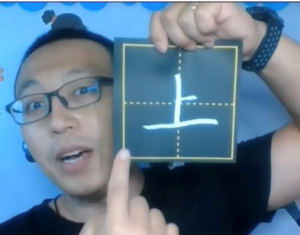
It looks like the flat ground and something coming up from the ground.
This one means “up, above, on”. It makes sense, right?
Now this one… do you see the ground again?
What do you think it means? Yes, it means “down, below, under”.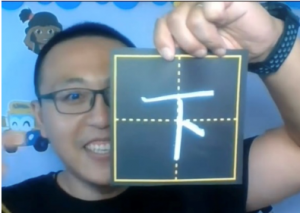
Okay, time for a harder one. First, let’s look at this part:
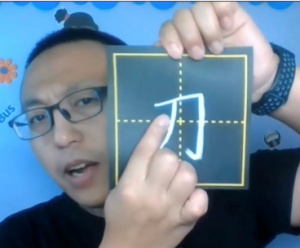
This one is from the first type of character- the pictures. It looks like a Chinese butcher knife and it means knife.
Now, we add a little something to make a story…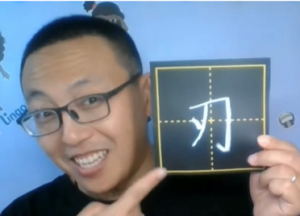 What is that? Something on the knife? What is on a knife? Oh, it’s almost like a little arrow pointing to… the blade. This character is 刃, blade. See, it tells a little story and with logic, you can remember and learn these characters too! On to Part Three…
What is that? Something on the knife? What is on a knife? Oh, it’s almost like a little arrow pointing to… the blade. This character is 刃, blade. See, it tells a little story and with logic, you can remember and learn these characters too! On to Part Three…
Part 3: Meaning and Sound
Uh oh, now it’s getting more complicated! Are you scared? These have more parts than one!! Usually, these characters have two parts. One part carries the meaning and the other tells us the sound or pronunciation of the character. Wait… that sounds pretty logical. Ok, let’s not waste time with explanations- let’s have the examples tell us their story.
![]() This is a simple character, 包, Bāo, which means “bag”. When it’s used in other characters, it loses its meaning and just keeps the sound “ao” (like “OW!”). It is added to characters to teach us how they are pronounced. Let’s see the examples:
This is a simple character, 包, Bāo, which means “bag”. When it’s used in other characters, it loses its meaning and just keeps the sound “ao” (like “OW!”). It is added to characters to teach us how they are pronounced. Let’s see the examples:
First one: 泡. On the right, you can see the character 包. This tells us that this character has the sound “ao” (to English speakers, you’d say “Ow!”). The left part gives us the meaning. You can see three drops of water. So, together, this word is pronounced “pào” it means “to soak” something in the water and it also means“bubbles”. Ooh, fluffy bubbles.
There are many words that use this left part, which means water:
![]() If you see this on the left of a character, it tells you that the character means something with water. Here’s another 包 word: 跑. It also has the “ao” sound, and you can see the character 包on the right. It has no meaning to the new character. What is the meaning? Look at the left part, 足. If you use your imagination, you can see a person with a square head, an arm, and a large foot.
If you see this on the left of a character, it tells you that the character means something with water. Here’s another 包 word: 跑. It also has the “ao” sound, and you can see the character 包on the right. It has no meaning to the new character. What is the meaning? Look at the left part, 足. If you use your imagination, you can see a person with a square head, an arm, and a large foot.
![]() This part represents our foot/feet. So, this character is pronounced “Pǎo” and it means “run”. It has the sound from 包 and the meaning from 足. Make sense? I think learning these parts will really help you to understand new characters that you meet. Let’s go to our last part!
This part represents our foot/feet. So, this character is pronounced “Pǎo” and it means “run”. It has the sound from 包 and the meaning from 足. Make sense? I think learning these parts will really help you to understand new characters that you meet. Let’s go to our last part!
Part 4: Understanding
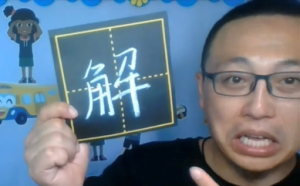
Uh, yikes, this one looks too hard.
Should we give up now?
Bye! I’m out of here…![]() (This is how I look when I run.)
(This is how I look when I run.)
Wait! I see some parts that I know! Remember that knife from before? 刀 – it can mean “cut”
And look below it- I see a cow 牛
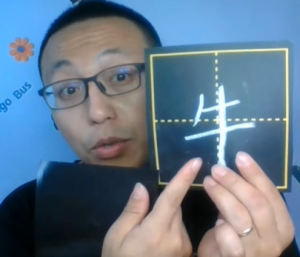
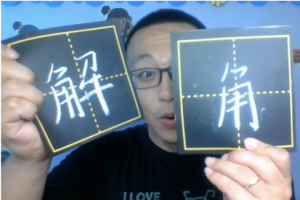
Then on the left is this character; it means horns:
So if you cut a cow just to get its horns, it’s destructive, right? This big, scary character means “destructive, destruction, separate, cut”. So, we can understand that pretty well, right?
We can group most of our characters into these four parts. I hope that I have made the characters a little less scary for you! Come see me in class and we can learn more together.

